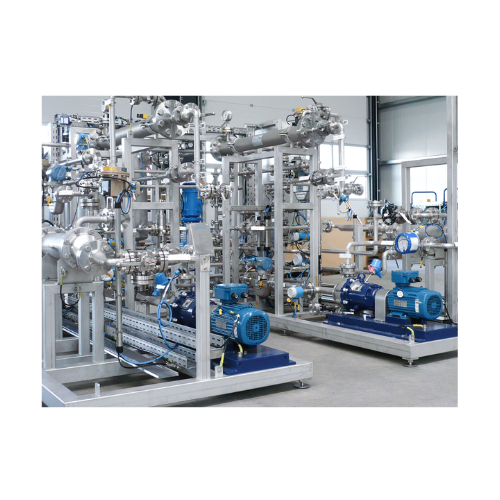Organic solvent nanofiltration for liquid separation
Optimize your process streams with solvent recovery that minimizes energy use, maintains the integrity of sensitive compounds, and eliminates complex thermal steps while ensuring high-purity outputs.

Separates and Purifies Solvent-Based Liquid Mixtures
The BORSIG Organic Solvent Nanofiltration (OSN) unit offers a robust solution for separating complex liquid mixtures in the petrochemical, chemical, pharmaceutical, and food industries. Utilizing a feed-and-bleed system, it facilitates gentle separation without thermal stress, preserving temperature-sensitive molecules and recovering valuable components efficiently. This innovative membrane technology allows for the effective concentration and purification of aromatics, active pharmaceutical ingredients (APIs), and homogeneous catalysts, while ensuring energy savings and reduced waste disposal costs. Its modular design provides flexibility in capacity adjustments and seamless integration into existing production lines. Constructed with solvent-resistant materials, the OSN unit is designed for durability and reliability in high-demand environments, ensuring minimal maintenance and downtime. Compliance with industry standards and customization options available for specific requirements make BORSIG OSN units an ideal choice for companies aiming to enhance their separation and recovery processes.
Benefits
- Reduces energy consumption and operating costs with non-thermal separation.
- Enhances product quality by achieving high-purity solvent recovery.
- Minimizes waste disposal and material losses through efficient component recovery.
- Provides operational flexibility with modular capacity adjustments.
- Ensures safe and reliable processing of temperature-sensitive substances.
- Applications
- Chemicals, Solvent-based waste streams, Natural oils, Food industry, Petrochemicals, Liquid hydrocarbons, Catalysts, Pharmaceuticals
- End products
- Aromatic hydrocarbons, Regenerated solvents, Recovered homogeneous catalysts, Active pharmaceutical ingredients (apis), Natural oil extracts, Fragrance oils, High-purity chemical solvents, Essential oils
- Steps before
- Extraction, Rectification, Feed Preparation, Catalyst Addition
- Steps after
- Solvent Evaporation, Crystallization, Product Purification, Decolourization
- Input ingredients
- liquid organic process mixtures, solvent-based waste streams, reaction mixtures, crystalline mother liquors, hexane-oil-miscella, natural oils, fresh feed mixture
- Output ingredients
- soluted molecules, highly purified solvent, active catalyst complex, solvent in liquid phase, decolourized natural oils, permeate stream, concentrate bleed
- Market info
- BORSIG is known for its expertise in manufacturing high-quality industrial engineered-to-order (ETO) equipment, including pressure vessels, heat exchangers, and compressors, with a strong reputation for engineering excellence and reliability in the petrochemical and chemical industries.
- Membrane Affinity
- 200 to 1000 g/mol
- Operation Conditions
- Mild
- Separation Process
- Non-thermal
- System Design
- Modular
- Process Type
- Feed-and-Bleed
- Energy Consumption
- Less energy intensive
- Capacity Adjustment
- Flexible
- Working mechanism
- Feed-and-Bleed system
- Integrated steps
- Membrane filtration, concentration, and recovery
- Batch vs continuous operation
- Continuous operation
- Energy efficiency
- Reduced energy usage compared to thermal methods
- Process simplification
- Debottlenecking potential
- Automation level
- Potential for integration with control systems
- Compatibility with organic solvents
- Yes
- Resistance to solvent-induced swelling
- High
- Chemical resistance
- Various organic solvents
- Temperature sensitivity
- Low
- Molecular weight selectivity
- 200 to 1, 000 g/mol
- Modular design
- Flexible capacity adjustment
- Catalyst recovery
- Homogeneous catalysts
- Solvent recovery
- Hexane-oil-miscella
- Decolourization
- Natural oils
- Modular design
- Flexible capacity adjustment
- System design
- Feed-and-Bleed system
- Footprint
- Compact
- Shape
- Modular units
- Recirculation
- Partial recirculation
- Feed method
- Feed pump
- Discharge method
- Continuous bleed stream
- Modular design
- Flexible capacity adjustment
- System configuration
- Feed-and-Bleed system
- Process scalability
- Modular integration



